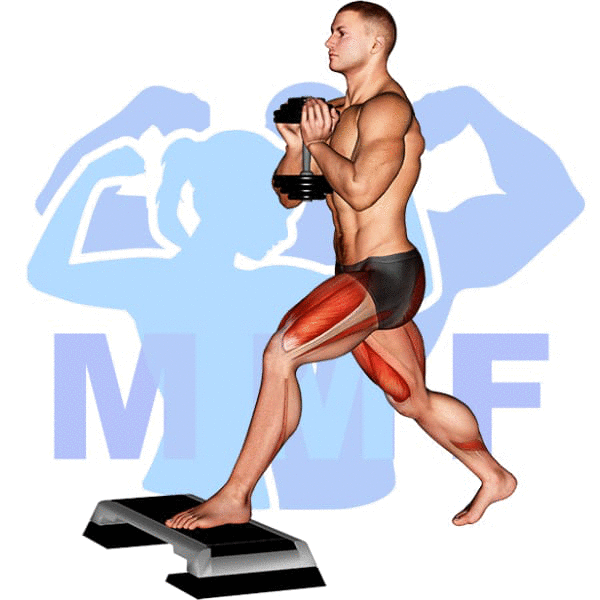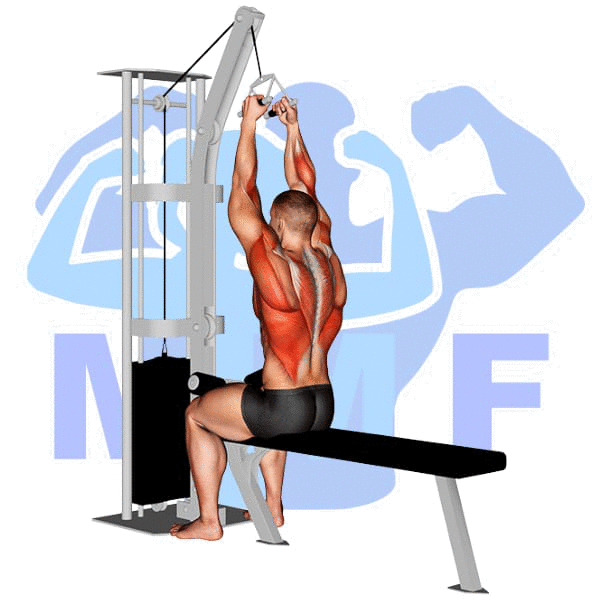The Dumbbell Bench Press is a Principal Compound Exercise
The Dumbbell Bench Press is a basic compound exercise that places higher absolute intensity on your chest and shoulders relative to barbell bench press. Because the Dumbbell Bench Press movement is a compound movement (An lift that involves two or more joints), it is a great chest exercise for developing both mass and strength; which is why it is a favorite chest exercise by many.
Basic Chest Physiology
- Upper Chest
- Middle Chest
- Lower Chest
- Inner Chest
- Outer Chest
Dumbbell Bench Press Overview
- Primary Muscle(s) Worked: Chest; Pectoralis Major, Clavicular
- Other Muscles Worked: Shoulders, Triceps
- Equipment: Dumbbells, Bench
- Mechanics Type: Compound
- Force: Push
- Utility: Basic
Target Muscles Used when Performing a Dumbbell Bench Press Movement
- Pectoralis Major, Sternal
Synergist Muscles Worked When Performing a Dumbbell Bench Press
- Pectoralis Major, Clavicular
- Deltoid, Anterior
- Triceps Brachii
Stabilizers Worked When Performing a Dumbbell Bench Press
- Biceps Brachii, Short Head
Muscle Fiber Recruitment for Dumbbell Bench Press
When you use dumbbells to perform a bench press movement, you maximize muscle fibers used because of the extra muscle needed to stabilize and balance the weight which is NOT used when using lever type and other chest building workout machines. Incorporating free weight exercises into your routine is the BEST way to build strength, balance, supporting muscles and develop the best well rounded and fully developed physique.
Dumbbell Bench Press Technique
- Grasp two dumbbells with an overhand grip.
- Sit down on the bench with dumbbells resting on lower thigh.
- Kick weights to shoulder and lie back facing up on the bench, with the knees bent to 90 degrees and the feet firmly on the floor. If the feet do not reach the ground, only then can you put them on the bench. The shoulder and elbow joints should both be at a 90-degree angle.
- Position the dumbbells to the sides of your upper chest with elbows under dumbbells.
- Arch the back slightly, tighten the abs and retract the scapulas. Make sure that the glutes stay in contact with the bench throughout the lift. Inhale and hold your breath.
- Feet are kept flat on the floor, weight on the heels, lower leg perpendicular to the floor, with the buttocks always in contact with the bench. Proper position prevents extreme arching of your lower back.
- Forcefully exhale as you push the dumbbells straight up until your elbows are extended.
- Squeeze the chest.
- Inhale as you slowly lower the dumbbells to the starting position.
- Repeat.
Caution Needed Performing Dumbbell Bench Press
Anyone with shoulder or elbow problems should be careful when using free weights to perform this exercise. You should consider the angle you use with the bench carefully. If you have any shoulder issues proceed with caution (if at all). Do not exceed a 30-degree angle if you have had any shoulder pain. If you are bothered by this exercise, be smart and avoid this exercise. There are plenty of other movements which deliver success without risk to your shoulders and elbows.
Possible Injuries when Performing Dumbbell Bench Press
The incorrect form may lead to multiple types of injuries including:
- Torn ligaments/tendons in shoulders.
- Back injuries due to bridging, which is the arching of the lower back. To prevent bridging, compress the stomach muscles to force the lower back down, or bring legs up and flat onto the bench.
Common Errors when Performing the Dumbbell Bench Press
The following errors are potentially dangerous and can result in injury. Avoid them at all costs.
- You are Using too Much Weight. A common mistake for many novice lifters is lifting too much. Lifting too heavy can result in poor form and possible injuries. Make sure to use a correct weight that will allow you to use proper form and the full range of motion.
- Bouncing and Jerking the Weight. Jerking or bouncing is also referred to as cheating and will take the emphasis off the chest. It can also result in losing control of the load leading to injuries.
- You are Losing Control of the Weight. You can pull ligaments and hurt your rotator cuff.
- Performing the movement too fast. Performing the action too quickly doesn’t allow you to recruit as many muscle fibers fully.
- Compromise Range of Motion. Going too deep if you have limited motion or are not adequately warmed up and stretched can result in a serious tendon, joint and muscle injury. Not using a full range of motion can also compromise results.
Dumbbell Bench Press Tips
- Use a spotter. A spotter can help monitor your form and also help you get those last few reps out!
- Begin with a lightweight to practice proper form and control and adequately warm up the shoulder girdle.
- Adjust the bench angle correctly. No more than 45-degree angle, otherwise too much emphasis is put on the shoulder.
- Use a smooth and controlled motion. A controlled movement will avoid cheating which in turn will take the emphasis off the chest.
- Do not arch the back and raise the glutes off the bench. Compress the stomach muscles to force the lower back down, or bring legs up and flat onto the bench (beginners should keep the feet on the floor because otherwise, they may lose their balance).
Dumbbell Bench Press Variations
Variations are intended to work different subgroups of muscles or work the same muscles in slightly different ways. There are plenty of variations to this strength exercise. Some other modifications of the Dumbbell Bench Press:
- Barbell Bench Press. Same movement as detailed above but using a barbell. The Barbell Bench Press is a compound movement that targets the Pectoralis Major, Sternal.
Dumbbell Bench Press Angle Variations
Dumbbell Bench Presses can be performed on an incline, on a decline, or a stabilizer ball. The incline-version shifts some of the stress from the pectorals to the anterior deltoids and gives a more significant stimulus to the upper pectorals. Whereas the decline allows you to lift more weight while using nearly the same musculature as the traditional bench press.
Angle variations include:
- Incline Dumbbell Bench Press. From an incline bench. Emphasis shoulders and upper chest.
- Decline Dumbbell Bench Press. From a decline bench. Allows you to lift more weight and emphasizes more of your lower chest.
Dumbbell Bench Press Complimentary Exercises
No exercise program should consist of machines alone, and no exercise program should only use free weights alone. Variety in the type of exercises you incorporate is what you need to develop your body. When creating a workout plan for any body part, including the chest it is good to include both machines and free weights, dumbbells, and barbells, and cables, mix up the angles and positioning so that you work the body part from different angles. It is also good to include isolation movements as well as compound movements too! The following are a few suggested exercises that would complement the Smith Machine Incline Bench Press:
- Decline Dumbbell Fly. Is an isolated dumbbell fly movement that targets the Pectoralis Major Sternal. When properly performed it will give you a full-width stretch of chest muscles, while concentrating mostly on the center of the chest. It is an excellent complimentary exercise to the Smith Machine Incline Press because: (1) it works the lower part of the chest instead of the upper part, and (2) as a free weight dumbbell exercise the decline dumbbell fly utilizes more muscle stabilizers required to balance and control the weight during exercise execution.
- Barbell Pullover. The Barbell Pullover is an advanced movement that when appropriately performed will hit the chest at different angles and employ muscle fibers not customarily recruited standard chest building movements such as the bench press, Pec Deck and flyes. Using the Dumbbell Pullover as part of your chest workout will aid in the full development of your chest pectorals.
- Smith Machine Incline Bench Press. The Smith Machine Incline Bench Press is one of the best exercises for targeting the upper chest (Pectoralis Major, Clavicular) and front deltoid. The Smith Machine also allows you to lift more weight because there is no weight in the bar (it’s counterweighted) and instead of worrying about dropping the equipment on your chest, you can twist the bar to lock it off when your muscles give way. Additionally, if you are the type of person who only uses free weights, adding the Smith Machine exercises may be just what you need to get your body through a plateau.
- Barbell Incline Bench Press. Same movements as detailed above but using a barbell. Barbells and dumbbells recruit additional muscle when training because you need to stabilize the motion by yourself.
- Dumbbell Incline Bench Press. Same movements as detail above but with dumbbells. Barbells and dumbbells recruit additional muscle when training because you need to stabilize the motion by yourself. Arms work independently of one another which can allow a deeper stretch at the bottom of the movement.
- Pec Deck. The Pec Deck Fly exercise is an isolation exercise commonly used to develop the chest (pectoral muscles). The Pec Deck Fly (Butterfly) main advantage is a set can be done quickly because all that is needed to change the weights is a pin, and the exercise can be done safely since less balance and control is required.
- Dips. Dips are a great overall chest exercise that helps build the entire chest muscle.
Bottom Line on the Dumbbell Bench Press
The Dumbbell Bench Press is a chest exercise that can be done at various angles to bring exceptional variety and overall muscle development to every part of the chest. The Dumbbell Bench Press is a great movement that should be included in every chest workout.




